Rev. Dr. Raymond R. Wilkinson
Roanoke, Virginia's Civil Rights Pioneer
ROANOKE NAACP PRESIDENT
(1959 - 1968)

REVEREND R.R. WILKINSON
In 1958, when Rev. R.R. Wilkinson came to Roanoke, Virginia the Roanoke NAACP chapter was nonexistent. Segregation was the law of the land in Virginia like most southern states during that time. African Americans faced constant racism and discrimination in Roanoke. There were no promotions for the few African Americans that were employed in Roanoke's police department, there were no people of color employed in Roanoke fire departments. There were no government positions offered to African Americans in Roanoke as well. Most African Americans in Roanoke were denied service in white only restaurants, hospitals, department stores and public facilities. Roanoke learning institutions such as schools and universities, city bus transportation, and hospitals in Roanoke, Virginia were all segregated by Jim Crow laws. These Jim Crow laws were created after the Civil War to separate Africans Americans from White Americans in southern states. The NAACP considered these laws immoral and unjust.
REV. R.R. WILKINSON BECOMES NAACP PRESIDENT
In early 1959, the NAACP executive board of directors in the state of Virginia were searching for a leader to head the NAACP chapter established in Roanoke, Virginia. At the time there were only a few black Civil Rights activist in Roanoke who argued against segregation however, none of them were effective in changing the status quo in Roanoke. The Virginia NAACP board of directors begin scouting black churches in Roanoke, Virginia searching for a minister to lead Roanoke's NAACP in the Civil Rights struggle. In 1959, Rev. R.R. Wilkinson's older brother Howard Marion Wilkinson was assistant executive secretary of the state of Virginia NAACP. He just got promoted to Executive Director of Virginia's NAACP conference in their political action program. Howard Wilkinson told his brother that there was an opening spot in Roanoke, Virginia as President of the NAACP Chapter and suggested he should take on the position. Rev. R.R. Wilkinson hesitated at first but after much reflection and prayer, he told his brother that he was interested. So, Howard Wilkinson convinced Virginia NAACP executive board of directors to consider his brother for President of the Roanoke NAACP branch. On a Sunday morning the NAACP executive board members visited Hill Street Baptist Church to listen to a 36-year-old pastor who gave a passionate sermon that ignited the congregation's spirits. Rev. R.R. Wilkinson spoke with a booming baritone voice that echoed throughout the halls of the church and simply commanded the congregation's attention. The NAACP board of directors could not help but feel the power and raw emotion of his sermon as he spoke of equal rights for African Americans in Roanoke. The Virginia NAACP board believed that they had finally found their leader. In late 1959, during a meeting held by the Virginia NAACP executive board members, Rev. R.R. Wilkinson was unanimously elected President of the NAACP Chapter in Roanoke, Virginia. Howard Wilkinson often said his brother "Took the ball and ran with it."
Howard Marion Wilkinson

Rev. Raymond R. Wilkinson

Roanoke NAACP President at Hill Street Baptist Church during a 1963 interview.
REV. R.R. WILKINSON TAKES LEAD ON INTEGRATION
During Rev. R.R. Wilkinson's tenure as President of the Roanoke NAACP he became a force to be reckoned with as an effective Civil Rights leader in Roanoke, Virginia. During the 1960's Civil Rights movement, Rev. R.R. Wilkinson implemented his plans for nonviolent demonstrations for integration throughout the city of Roanoke with his strategic planning and phenomenal negotiation skills. Rev. R.R. Wilkinson would become a rebel with a cause as he spearheaded integration in Roanoke, Virginia by defying racist segregation laws. He established a secret Biracial Committee to combat racism and planned lunch counter sit-ins peacefully without Roanoke government interference. Under the Rev. R.R. Wilkinson's bold leadership, Roanoke begins to break down racial barriers much earlier than most southern cities in the 1960's.
"OUR FATHERS BUILT THIS COUNTRY!"
(Press play button)
On Monday June 10th, 1963, about 50 Civil Rights marchers had gathered outside Danville, Virginia jail at night to hold a prayer vigil for those who had been arrested during protests earlier in the day. White deputized police officers, state troopers, and firemen carrying high-pressure fire hoses and nightsticks injured about 47 black demonstrators, turning the event into a pivotal moment for Danville’s Civil Rights movement. It was also the most violent incident in the history of Virginia's Civil Rights movement becoming known as Bloody Monday. A NAACP meeting was held on June 22nd, 1963, at First Baptist Church in Roanoke, Virginia led by Roanoke NAACP President Rev. R.R. Wilkinson. The Rev. A.I. Dunlap from Danville, Virginia spoke about the "Bloody Monday" incident. The Rev. R.R. Wilkinson opened the meeting with a blast at what he termed as the white man's domination of the Negro! He also spoke on why he is not afraid to fight for his rights!
REV. R.R. WILKINSON SHOWS A WHITE NAZI SUPREMACIST THE DOOR!
(Video has no sound)
On October 30th, 1965, the Virginia State NAACP Conference was holding their session at the Hotel Roanoke. Suddenly, out of nowhere a member of the Nazi party a man name Douglas Lindberg Niles interrupted the conference throwing paper as he shouted out racial slurs at NAACP members. He told them that he represented the white Nazi Party leader George Lincoln Rockwell. A great scuffle started, and some punches were thrown before several NAACP men quickly took charge; rushing to restrain him then taking him out of the ballroom into police custody. One of those men who grabbed the Nazi Supporter to take him out the building was President of the NAACP in Roanoke, Virginia the Rev. R.R. Wilkinson.

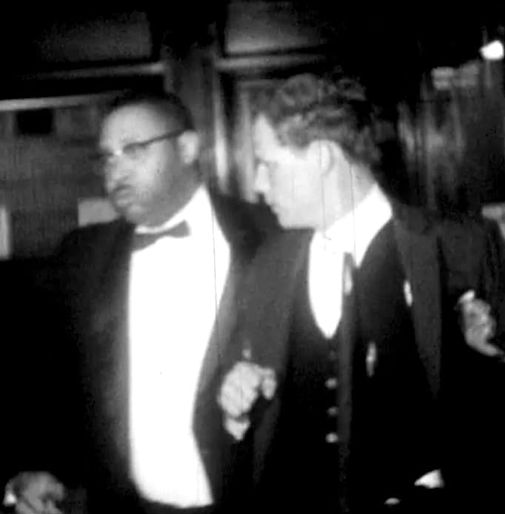
REV. R.R. WILKINSON FIGHTS JOB DISCRIMINATION AND SUPPORTS VOTING RIGHTS
In 1963, Rev. R.R. Wilkinson advocated for the hiring and promotion of African Americans in Roanoke police stations, fire stations, schools, hospitals, local government, Roanoke city public transportation department, department drug stores and restaurants. He also fought hard against job discrimination for African Americans in Roanoke. In response to Roanoke white merchant’s reluctance in hiring blacks, Rev. R.R. Wilkinson threaten to initiate a "Selective Buying" campaign where blacks would only shop in stores where they were hired. As a result of Rev. Wilkinson's threats, 14 department stores started hiring African Americans. Roanoke Police Department integrated in the late 1940's however, African American police officers could only patrol black neighborhoods and were restricted from going into white neighborhoods. If a white person were involved in a crime, the black police officers would have to call white officers to the scene because black officers were not allowed to arrest a white person in Roanoke. With the arrival of Rev. R.R. Wilkinson as President of Roanoke NAACP in the 1960's, things begin to change within the police department. The NAACP begin putting pressure on Roanoke Police to promote more black officers. Rev. R.R. Wilkinson utilized the Roanoke Biracial Committee by negotiating with Roanoke's police chief and Mayor Stoller so he would convince the police chief to start promoting black police officers to detectives. Rev. R.R. Wilkinson was also highly instrumental in registering many African Americans in Roanoke to vote for the first time after the Voting Rights act of 1965 passed in Congress.
![20201230_032719[1].jpg](https://static.wixstatic.com/media/0af04d_2839cdaf47704160ba3b505b2cc9c42b~mv2.jpg/v1/crop/x_0,y_0,w_1080,h_622/fill/w_881,h_505,al_c,q_85,usm_0.66_1.00_0.01,enc_avif,quality_auto/20201230_032719%5B1%5D.jpg)
Photo of two black policemen in a integrated Roanoke Police Department during the 1950's.
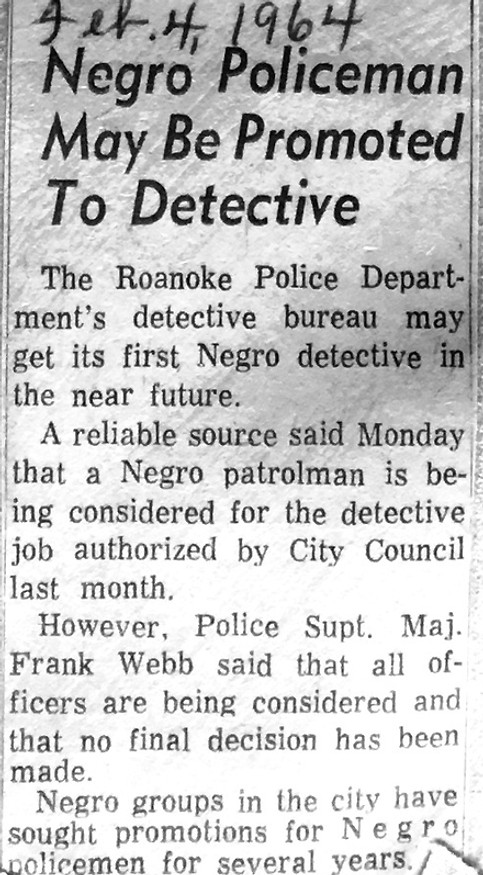
"FREE IN 63"
(Press play button)
On May 21st, 1963 Rev. R.R. Wilkinson speaks on the Civil Rights issues concerning the dump, segregation, and job discrimination in Roanoke.
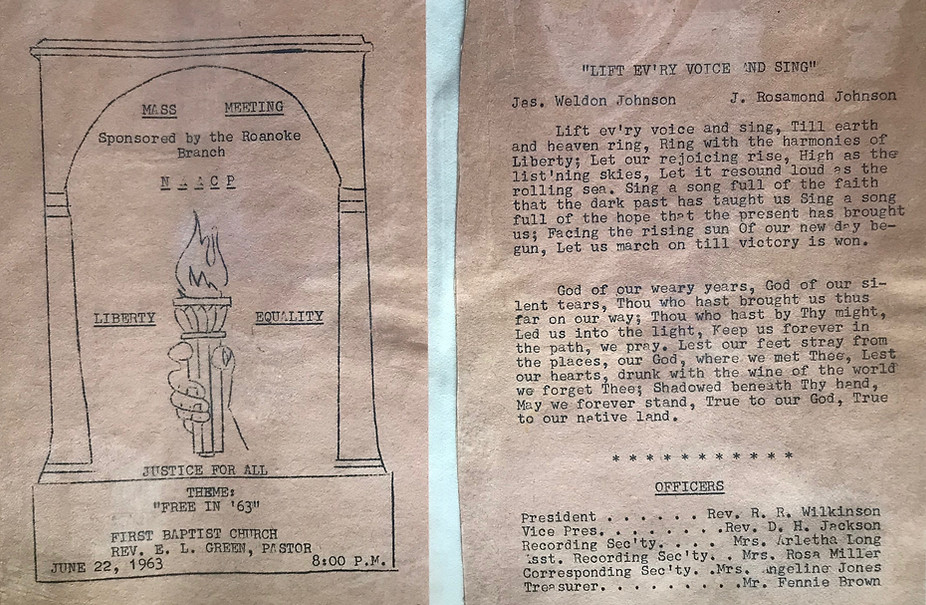
REV. R.R. WILKINSON PLANS NAACP TRIP TO 1963 MARCH IN WASHINGTON DC

Courtesy of The Roanoke Times
"BLOOD IS ON YOUR HANDS!"
September 17th, 1963
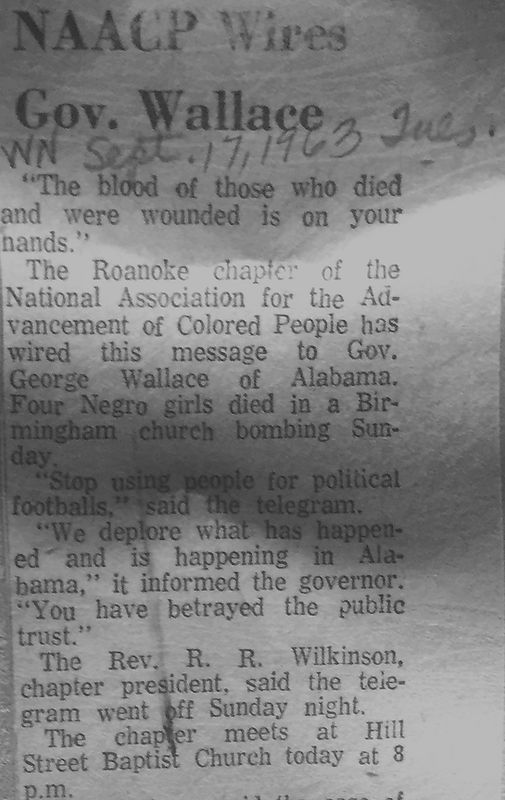
Courtesy of The Roanoke Times
REV. R.R. WILKINSON HOLDS MEMORIAL SERVICE FOR PRESIDENT JOHN F. KENNEDY IN 1963
Courtesy of WDBJ 7 News
(Press play button)
On November 22nd, 1963, President John F. Kennedy was assassinated in Dallas, Texas. On November 25th, 1963, Rev. R.R. Wilkinson held a memorial service in President Kennedy's honor at First Baptist Church in Roanoke, Virginia. Rev. R.R. Wilkinson honored President Kennedy for taking on Civil Rights before his untimely death.
REV. DR. R.R. WILKINSON MARCHES WITH REV. DR. MARTIN LUTHER KING JR. IN 1965
In 1965, Rev. Dr. R.R. Wilkinson planned a trip to Selma, Alabama in solidarity with victims of "Bloody Sunday.'' On March 7th, 1965, 600 marches were injured and beaten by Alabama State Troopers while marching across Edman Pettus Bridge in Selma, AL for voting rights. On March 21st, 1965, Rev. Dr. R.R. Wilkinson and Rev. Elbert Moses Fulgham traveled to Selma, Alabama. Both Rev. Wilkinson and Rev. Fulgham marched with Rev. Dr. Martin Luther King Jr. for 55 miles and 5 days from Selma to the steps of the Alabama Capitol building in Montgomery. They were among the 25,000 people who witnessed Rev. Dr. King deliver his famous speech "How Long, Not Long".
REV. DR. R.R. WILKINSON BECOMES PRESIDENT OF THE BAPTIST PASTORS CONFERENCE OF ROANOKE, SALEM, AND VINTON, VIRGINIA IN 1968.
After serving 9 years as President of the Roanoke NAACP Chapter Rev. R.R. Wilkinson stepped down in 1968. He was succeeded by the Rev. Charles T. Greene who served from (1968 to 1970) and again from (1992 to 1995). Rev. Al Holland was voted Roanoke NAACP President from (1970 to 1974) and then Rev. Carl T. Tinsley became Roanoke NAACP President from 1975 through the 1980's.
Dr. Brenda Hale was elected as the President of the Roanoke Branch NAACP in 2000. She helped reinvent the Roanoke NAACP Youth Council and advocated for educational opportunities for students to pursue college. Dr. Brenda Hale is the longest serving President of the Roanoke NAACP Chapter serving her 8th term in 2025.
Later in 1968, Rev. R.R. Wilkinson is elected President of the Baptist Pastors Conference of Roanoke, Salem and Vinton, Virginia.
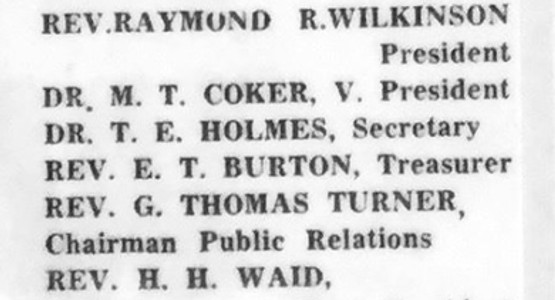
Rev. R.R. Wilkinson's staff as President of the Baptist Pastors Conference in 1968.
REV. DR. R.R. WILKINSON BECOMES THE 3RD AFRICAN AMERICAN PRESIDENT OF THE ROANOKE VALLEY MINISTERS CONFERENCE IN 1978.
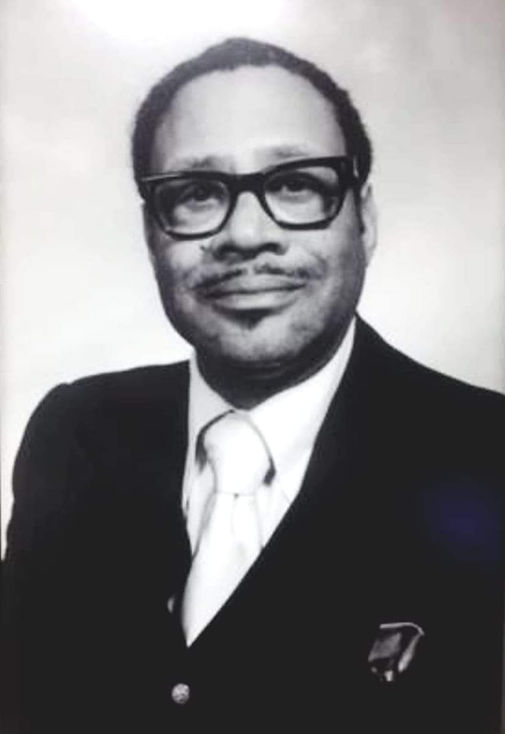
Reverend Dr. R.R. Wilkinson
President of the Roanoke Valley Ministers Conference photo in 1978.
REV. DR. R.R. WILKINSON HONORED
![20210115_183659[1].jpg](https://static.wixstatic.com/media/0af04d_b689a5db77394ada96520fa40dcc98e1~mv2.jpg/v1/fill/w_500,h_1005,al_c,q_85,usm_0.66_1.00_0.01,enc_avif,quality_auto/20210115_183659%5B1%5D.jpg)
![20210116_142321[1].jpg](https://static.wixstatic.com/media/0af04d_c650b3c9b1544f138629723232b53097~mv2.jpg/v1/fill/w_555,h_740,al_c,q_85,usm_0.66_1.00_0.01,enc_avif,quality_auto/20210116_142321%5B1%5D.jpg)
![20210115_184249[1].jpg](https://static.wixstatic.com/media/0af04d_67b5b80caf7244cab5f37d41a269f136~mv2.jpg/v1/fill/w_685,h_705,al_c,q_85,usm_0.66_1.00_0.01,enc_avif,quality_auto/20210115_184249%5B1%5D.jpg)
Rev. R.R. Wilkinson's youngest daughter Danita Wilkinson introducing his brother Howard Marion Wilkinson at Rev. R.R. Wilkinson's celebration ceremony.
![20210115_184227[1].jpg](https://static.wixstatic.com/media/0af04d_9d9aa9ba5e51401da9eb1107922f64da~mv2.jpg/v1/fill/w_922,h_555,al_c,q_85,usm_0.66_1.00_0.01,enc_avif,quality_auto/20210115_184227%5B1%5D.jpg)
Rev. R.R. Wilkinson daughters each received roses in honor of their father's civil rights legacy in Roanoke. (left from right; Cassandra Wilkinson Lighty, Nadine Wilkinson Johnson, Danita Wilkinson.
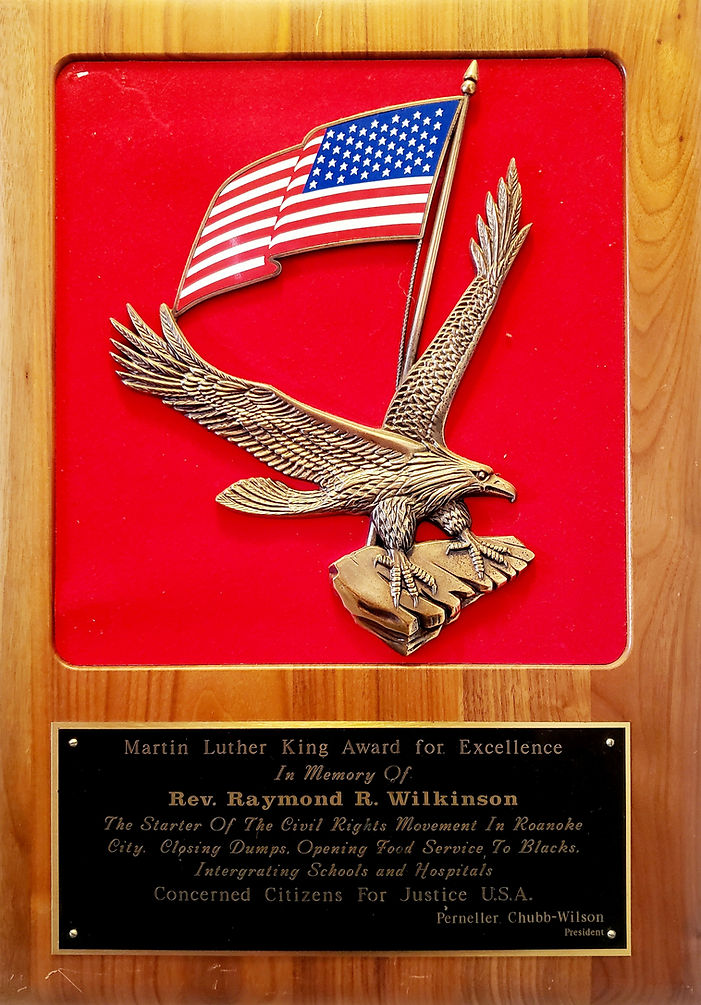
The Rev. Dr. R.R. Wilkinson's strategic negotiation skills, courage, and steadfast persistence caused integration to spread throughout Roanoke, Virginia rapidly during the 1960's Civil Rights Movement. Rev. R.R. Wilkinson is known for being the most effective, progressive, and outspoken NAACP President in Roanoke's history.